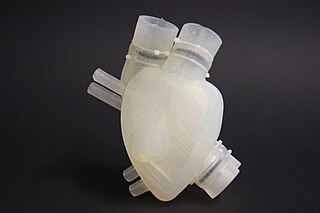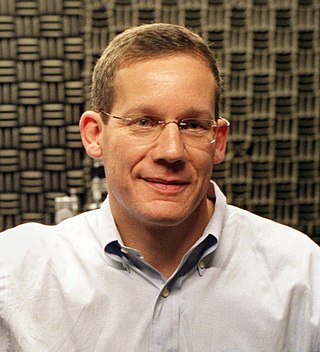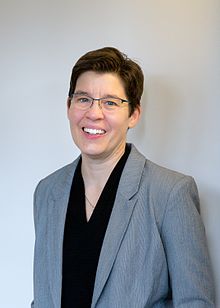
Organ printing utilizes techniques similar to conventional 3D printing where a computer model is fed into a printer that lays down successive layers of plastics or wax until a 3D object is produced. In the case of organ printing, the material being used by the printer is a biocompatible plastic. The biocompatible plastic forms a scaffold that acts as the skeleton for the organ that is being printed. As the plastic is being laid down, it is also seeded with human cells from the patient's organ that is being printed for. After printing, the organ is transferred to an incubation chamber to give the cells time to grow. After a sufficient amount of time, the organ is implanted into the patient.

Charles M. Lieber is an American chemist, inventor, nanotechnologist, and writer. In 2011, Lieber was named the leading chemist in the world for the decade 2000–2010 by Thomson Reuters, based on the impact of his scientific publications. He is known for his contributions to the synthesis, assembly and characterization of nanoscale materials and nanodevices, the application of nanoelectronic devices in biology, and as a mentor to numerous leaders in nanoscience.

Uma Chowdhry is an American chemist whose career has been spent in research and management positions with E. I. du Pont de Nemours and Company. She has specialized in the science of ceramic materials, including catalysts, proton conductors, superconductors and ceramic packaging for microelectronics.
Ilesanmi Adesida is a Nigerian American physicist of Yoruba descent. He has been the provost at Nazarbayev University in Astana, Kazakhstan, from September 2016.

Donald E. Ingber is an American cell biologist and bioengineer. He is the founding director of the Wyss Institute for Biologically Inspired Engineering at Harvard University, the Judah Folkman Professor of Vascular Biology at Harvard Medical School and Boston Children's Hospital, and Professor of Bioengineering at the Harvard John A. Paulson School of Engineering and Applied Sciences. He is also a member of the American Institute for Medical and Biological Engineering, the National Academy of Engineering, the National Academy of Medicine, the National Academy of Inventors, and the American Academy of Arts and Sciences.

Jennifer Anne Doudna is an American chemist who has done pioneering work in CRISPR gene editing, and made other fundamental contributions in biochemistry and genetics. Doudna was one of the first women to share a Nobel in the sciences. She received the 2020 Nobel Prize in Chemistry, with Emmanuelle Charpentier, "for the development of a method for genome editing." She is the Li Ka Shing Chancellor's Chair Professor in the department of chemistry and the department of molecular and cell biology at the University of California, Berkeley. She has been an investigator with the Howard Hughes Medical Institute since 1997.

Rashid Bashir is Dean of The Grainger College of Engineering, Grainger Distinguished Chair in Engineering and Professor of Bioengineering, at the University of Illinois at Urbana-Champaign. He was the Executive Associate Dean and Chief Diversity Officer at the Carle-Illinois College of Medicine at UIUC. Previously, he was the Abel Bliss Professor of Engineering.

Zhenan Bao is a chemical engineer. She serves as K. K. Lee Professor of Chemical Engineering at Stanford University, with courtesy appointments in Chemistry and Material Science and Engineering. She served as the Department Chair of Chemical Engineering from 2018 to 2022. Bao is known for her work on organic field-effect transistors and organic semiconductors, for applications including flexible electronics and electronic skin.

Joanna Aizenberg is a professor of chemistry and chemical biology at Harvard University. She is the Amy Smith Berylson Professor of Materials Science at Harvard's School of Engineering and Applied Sciences, the co-director of the Kavli Institute for Bionano Science and Technology and a core faculty member of the Wyss Institute for Biologically Inspired Engineering. She is a prominent figure in the field of biologically inspired materials science, having authored 90 publications and holding 25 patents.
Robocasting is an additive manufacturing technique analogous to Direct Ink Writing and other extrusion-based 3D-printing techniques in which a filament of a paste-like material is extruded from a small nozzle while the nozzle is moved across a platform. The object is thus built by printing the required shape layer by layer. The technique was first developed in the United States in 1996 as a method to allow geometrically complex ceramic green bodies to be produced by additive manufacturing. In robocasting, a 3D CAD model is divided up into layers in a similar manner to other additive manufacturing techniques. The material is then extruded through a small nozzle as the nozzle's position is controlled, drawing out the shape of each layer of the CAD model. The material exits the nozzle in a liquid-like state but retains its shape immediately, exploiting the rheological property of shear thinning. It is distinct from fused deposition modelling as it does not rely on the solidification or drying to retain its shape after extrusion.

Yueh-Lin (Lynn) Loo is a Malaysian-born chemical engineer and the Theodora D. '78 and William H. Walton III '74 Professor in Engineering at Princeton University, where she is also the Director of the Andlinger Center for Energy and the Environment. She is known for inventing nanotransfer printing. Loo was elected a Fellow of the Materials Research Society in 2020.
Mukta Ghate Farooq is an Indian metallurgical engineer of Marathi descent working for the IBM Corporation in Hopewell Junction, New York. She was named a Fellow of the Institute of Electrical and Electronics Engineers (IEEE) in 2016 for her contributions to 3D integration and interconnect technology. She is currently a Distinguished Research Staff Member at IBM Research and has over 220 issued US patents including patent numbers 10199315, 20180061749, and 8367543. In 2017, IIT Bombay awarded her the notable alumna award

Judith Louise MacManus-Driscoll is a Professor of Materials Science at the University of Cambridge. Driscoll is known for her interdisciplinary work on thin film engineering. She has a particular focus on functional oxide systems, demonstrating new ways to engineer thin films to meet the required applications performance. She has worked extensively in the fields of high temperature superconductors, ferroics and multiferroics, ionics, and semiconductors. She holds several licensed patents.
Heli Maarit Jantunen is a Finnish Professor of Technology at the University of Oulu and a member of the Scientific Advisory Board for the National Defense. She works on microelectronics and is a member of the 6G Flagship.

Jennifer L. M. Rupp FRSC is a material scientist and professor at the Technical University of Munich, visiting professor at the Massachusetts Institute of Technology and the CTO for battery research at TUM International Energy Research. Rupp has published more than 130 papers in peer reviewed journals, co-authored 7 book chapters and holds more than 25 patents. Rupp research broadly encompasses solid state materials and cell designs for sustainable batteries, energy conversion and neuromorphic memory and computing.
Susmita Bose is an Indian-American scientist and engineer, best known for her research on biomaterials, 3D printing or additive manufacturing of bone implants and natural medicine. She is the Herman and Brita Lindholm Endowed Chair Professor in the School of Mechanical and Materials Engineering at Washington State University.
Elisabetta Matsumoto is an American physicist whose scientific interests include the study of knitted fabrics' special mathematical and mechanical properties.
Jennifer Lyn Truman Bernhard is an American electrical engineer. She is the Donald Biggar Willett Professor in Electrical and Computer Engineering at the University of Illinois Urbana-Champaign. In 2010, Bernhard was elected a Fellow of the Institute of Electrical and Electronics Engineers (IEEE) for her development of multifunctional, reconfigurable, and integrated antennas.
Haiyan Wang is an American engineer. As the Basil S. Turner Professor of Engineering at Purdue University's School of Materials Engineering and the School of Electrical and Computer Engineering, she is a Fellow of the National Academy of Inventors, American Association for the Advancement of Science, American Ceramic Society, and American Physical Society.
The Wyss Institute for Biologically Inspired Engineering is a cross-disciplinary research institute at Harvard University focused on bridging the gap between academia and industry by drawing inspiration from nature's design principles to solve challenges in health care and the environment. It is focused on the field of biologically inspired engineering to be distinct from bioengineering and biomedical engineering. The institute also has a focus on applications, intellectual property generation, and commercialization.











